Knapping
Knapping is the shaping of flint, chert, obsidian, or other conchoidal fracturing stone through the process of lithic reduction to manufacture stone tools, strikers for flintlock firearms, or to produce flat-faced stones for building or facing walls, and flushwork decoration. The original Germanic term knopp meant to strike, shape, or work, so it could theoretically have referred equally well to making statues or dice. Modern usage is more specific, referring almost exclusively to the hand-tool pressure-flaking process pictured. It is distinguished from the more general verb "chip" (to break up into small pieces, or unintentionally break off a piece of something) and is different from "carve" (removing only part of a face), and "cleave" (breaking along a natural plane).
.jpg.webp)
Method
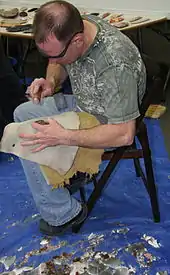
Flintknapping or knapping is done in a variety of ways depending on the purpose of the final product. For stone tools and flintlock strikers, chert is worked using a fabricator such as a hammerstone to remove lithic flakes from a nucleus or core of tool stone. Stone tools can then be further refined using wood, bone, and antler tools to perform pressure flaking.
For building work a hammer or pick is used to split chert nodules supported on the lap. Often the chert nodule will be split in half to create two cherts with a flat circular face for use in walls constructed of lime. More sophisticated knapping is employed to produce near-perfect cubes which are used as bricks.
Tools
There are many different methods of shaping stone into useful tools. Early knappers could have used simple hammers made of wood or antler to shape stone tools. The factors that contribute to the knapping results are varied, but the EPA (exterior platform angle) indeed influences many attributes, such as length, thickness and termination of flakes.[1]
Hard hammer techniques are used to remove large flakes of stone. Early knappers and hobbyists replicating their methods often use cobbles of very hard stone, such as quartzite. This technique can be used by flintknappers to remove broad flakes that can be made into smaller tools. This method of manufacture is believed to have been used to make some of the earliest stone tools ever found, some of which date from over 2 million years ago.
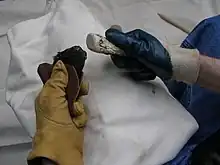
Soft hammer techniques are more precise than hard hammer methods of shaping stone. Soft hammer techniques allow a knapper to shape a stone into many different kinds of cutting, scraping, and projectile tools. These "soft hammer" techniques also produce longer, thinner flakes, potentially allowing for material conservation or a lighter lithic tool kit to be carried by mobile societies.[2]
Pressure flaking involves removing narrow flakes along the edge of a stone tool. This technique is often used to do detailed thinning and shaping of a stone tool. Pressure flaking involves putting a large amount of force across a region on the edge of the tool and (when successful) causing a narrow flake to come off of the stone. Modern hobbyists often use pressure flaking tools with a copper or brass tip, but early knappers could have used antler tines or a pointed wooden punch; traditionalist knappers still use antler tines and copper-tipped tools. The major advantage of using soft metals rather than wood or bone is that the metal punches wear down less and are less likely to break under pressure.
Uses
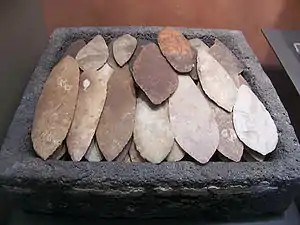
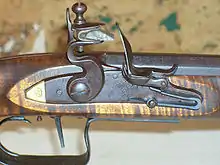

In cultures that have not adopted metalworking technologies, the production of stone tools by knappers is common, but in modern cultures the making of such tools is the domain of experimental archaeologists and hobbyists. Archaeologists usually undertake the task so that they can better understand how prehistoric stone tools were made.
Knapping is often learned by outdoor enthusiasts.
Knapping gun flints, used by flintlock firearms was formerly a major industry in flint-bearing locations, such as Brandon in Suffolk, England and the small towns of Meusnes and Couffy in France.[3] Meusnes has a small museum dedicated to the industry.
In 1804, during the Napoleonic Wars, Brandon was supplying over 400,000 flints a month for use by the British Army and Navy.[4] Brandon knappers made gun flints for export to Africa as late as the 1960s.
Knapping for building purposes is still a skill that is practiced in the flint-bearing regions of southern England, such as Sussex, Suffolk, and Norfolk, and in northern France, especially Brittany and Normandy, where there is a resurgence of the craft due to government funding.[5]
Health hazards
Historically, flint knappers commonly suffered from silicosis, due to the inhalation of flint dust. This has been called "the world's first industrial disease".[3][6]
When gun flint knapping was a large-scale industry in Brandon, Suffolk, silicosis was widely known as knappers' rot.[7] It has been claimed silicosis was responsible for the early death of three-quarters of Brandon gun flint makers. In one workshop, seven of the eight workers died of the condition before the age of fifty.[3]
Modern knappers are advised to work in the open air to reduce the dust hazard, and to wear eye and hand protection.[3] Some modern knappers wear a respirator to guard against dust.[6]
Contemporary study
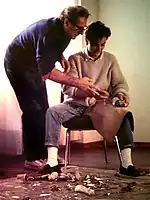
Modern American interest in knapping can be traced back [8] to the study of a California Native American called Ishi who lived in the early twentieth century. Ishi taught scholars and academics traditional methods of making stone tools and how to use them for survival in the wild. Early European explorers to the New world were also exposed to flint knapping techniques. Additionally, several pioneering nineteenth-century European experimental knappers are also known and in the late 1960s and early 1970s experimental archaeologist Don Crabtree published texts such as "Experiments in Flintworking". François Bordes was an early writer on Old World knapping; he experimented with ways to replicate stone tools found across Western Europe. These authors helped to ignite a small craze in knapping among archaeologists and prehistorians.
English archaeologist Phil Harding is another contemporary expert, whose exposure on the television series Time Team has led to him being a familiar figure in the UK and beyond. Many groups, with members from all walks of life, can now be found across the United States and Europe. These organizations continue to demonstrate and teach various ways of shaping stone tools.
See also
References
- Dibble, Harold; Whittaker, John (1981). "New Experimental Evidence on the Relation Between Percussion Flaking and Flake Variation". Journal of Archaeological Science. 8 (3): 283–296. doi:10.1016/0305-4403(81)90004-2.
- Peclin, Andrew (1997). "The Effect of Indentor Type on Flake Attributes: Evidence from a Controlled Experiment". Journal of Archaeological Science. 24 (7): 613–621. doi:10.1006/jasc.1996.0145.
- "Basic Tool Production Techniques, Health and Safety". ancientcrafts.co.uk. Archived from the original on 14 September 2015. Retrieved 23 August 2015.
- Whittaker, John (2001). "The Oldest British Industry: continuity and obsolescence in a flintknapper's sample set" (PDF). Antiquity. 75 (288): 382–90. doi:10.1017/s0003598x00061032. S2CID 163235035. Archived from the original (PDF) on 2020-04-28. Retrieved 2015-08-18.
- "Architectural flintwork".
- Kalin, Jeffery (2010). "Flintknapping and Silicosis". Pudget Sound Knappers. Retrieved 24 August 2015.
- Batty Shaw, A (1981). "Knapper's Rot, Silicosis in East Anglian Flint Knappers". Medical History. 25 (2): 151–168. doi:10.1017/s0025727300034359. PMC 1139012. PMID 7012479.
- Whittaker 1994:56-58
Further reading
- Crabtree, Donald (January 1971). Experiments in Flintworking. Idaho State University Museum. p. 102. ASIN B0006XPAQU.
- Waldorf, D.C. (1994). The Art of Flint Knapping (Paperback) (4th ed.). Mound Builder Books, Branson MO, USA. p. 76. (Excellent illustrations by Valerie Waldorf of processes, techniques, hand tools, ancient and modern knapped artifacts [mostly North American]. On front and rear cover are photos of precisely knapped replicas of prehistoric points and within the text are B&W photos including two full-scale [12⅝ inch and 10¾ inch] "Danish dagger" replicas made by the author.)
- Whittaker, John C. (1994). Flintknapping : Making and Understanding Stone Tools (Paperback). University of Texas Press. p. 351. ISBN 0-292-79083-X.
External links
- Museum of Stone Tools - Interactive 3D models of stone tool artefacts